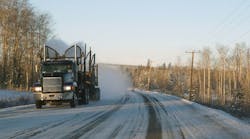There’s no worse sound on a cold winter morning than the sputter of a diesel engine that won’t start. No matter how much freight you need to deliver, it’s not going anywhere if cold weather gets the best of your rig.
It’s no secret that diesel engines can be temperamental in the winter. Every year, fleet owners get an unwelcome reminder of this. But your operation doesn’t have to hinge on the mercy of Old Man Winter. Here’s what you need to know to put cold weather diesel problems on ice.
Why cold weather causes diesel problems
Before diesel fuel enters an engine, it passes through a filter to strain out impurities. This filter is an incredibly important part of your equipment, but it’s also a prime target for cold weather to wreak havoc.
There’s a naturally occurring substance in No. 2 diesel fuel called paraffin wax. Under normal conditions, this wax remains in liquid form, so it’s harmless to your equipment. The problem occurs when cold temperatures cause paraffin wax to solidify and bind together into larger crystals that can’t flow through the filter. When diesel users talk about gelling, this is the issue they’re referring to.
Gelling starts to occur at a specific temperature known as the cloud point, coined after the white haze — or “cloud” — that appears as paraffin wax crystalizes. No. 2 diesel fuel has a cloud point of 14 degrees Fahrenheit.
If the temperature continues dropping, it will eventually reach a point where wax crystals collect rapidly on the fuel filter, starving the engine of fuel. This threshold is known as the cold filter plugging point (CFPP), and it indicates the lowest possible temperature at which a given diesel fuel can still pass through a 45-micron filter. For most No. 2 diesel fuels, the CFPP is typically within a few degrees of the cloud point.
While CFPP is an industry-wide measurement, it can be less accurate for some modern rigs. Today’s high-performance diesel engines require finer filters than those used in measuring CFPP, meaning a new diesel engine can potentially plug at a warmer temperature than its fuel’s documented CFPP. While CFPP can be a helpful measurement in some instances, keep in mind its limitations.
It should be noted that both cloud point and CFPP are natural properties of a fuel and thus impossible to change. Paraffin wax will always crystalize when the temperature gets cold enough. How, then, do you stop wintertime gelling and filter plugging? Even though you can’t change cloud point or CFPP, there’s a third factor you can change.
How to prevent diesel from gelling
The solution to cold-weather gelling and filter plugging lies in one key metric: operability. Defined as the lowest possible temperature a piece of equipment can function at without a loss of power, operability is the variable diesel equipment owners have power over.
But if you can’t stop paraffin wax from crystallizing, how is it possible to lower a rig’s minimum operating temperature? Well, even though you can’t get rid of the wax crystals in a No. 2 diesel, you can change their shape. Therein lies the secret to improving your rigs’ cold weather operability.
There’s a special fuel additive called a cold flow improver (CFI) that dissolves the bonds in paraffin wax. By breaking up larger crystals into many smaller parts, a CFI enables paraffin wax to pass smoothly through the filter. Typically, a CFI is effective down to about zero degrees Fahrenheit.
Steps to winterize your diesel fuel
Adding a CFI is the first step to fully protecting your diesel against cold-weather gelling and filter plugging. As temperatures continue to drop, you’ll want to replace your No. 2 diesel with a No. 1, which is free of paraffin wax and therefore offers the best operability during the coldest parts of winter.
You don’t want to make the switch all at once, though. It’s important to transition your equipment from a No. 2 to a No. 1 diesel gradually. Here are the steps you’ll want to take:
- Once the temperature falls below 35 degrees Fahrenheit, use a blend of about 70% No. 2 diesel and 30% No. 1, along with a CFI. For an even better solution, try Cenex Roadmaster XL Seasonally Enhanced or Ruby Fieldmaster Seasonally Enhanced premium diesel fuels, which are enhanced not only with a CFI, but also a complete additive package.
- As winter sets in, blend 30% No. 2 with 70% No. 1, continuing to mix in a CFI. For enhanced low-temperature operability, try Cenex Wintermaster winterized premium diesel fuel. Formulated with the optimal diesel fuel blend for the cold, Wintermaster also contains a complete additive package designed to keep engines protected.
- Anytime the temperature drops below minus-30 degrees Fahrenheit, use straight No. 1 diesel. To keep additives at proper levels, try No. 1 Diesel Fuel With Cenex Premium Diesel Fuel Additive.
Watch for diesel fuel icing
On a related note, it’s also important to keep an eye on your rigs for signs of fuel icing. Often, icing can be mistaken for gelling because it produces similar engine-stalling symptoms. The difference with icing is that, instead of wax crystals building up on the fuel filter, it’s ice crystals. Icing is a major concern because it means water has gotten into your fuel. If you find water in your fuel system, be sure to consult a licensed mechanic.
Winter can be rough on diesel equipment. The good news is that you don’t have to gamble with your operation. For fuel that works as hard as you do, use Cenex Winterized Premium Diesel, and you can leave fuel gelling and filter plugging out in the cold.



